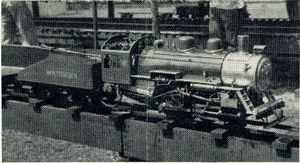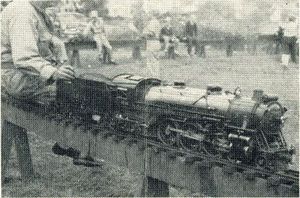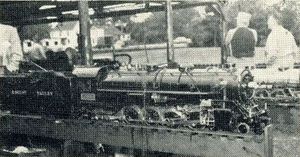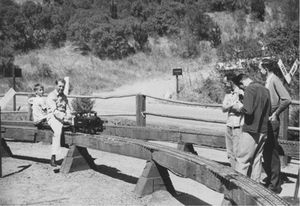IBLS Journal 1952: Difference between revisions
| Line 24: | Line 24: | ||
The Atlantic of Ernie Stalder with its stainless steel parts and boiler jacket certainly would attract a lot of attention at any meeting. Not only that, but its performance was equal to its appearance. The six engines that the [[Southeastern Live Steamers]] brought to the meeting were good reliable performers and could keep their position in any parade of our small jobs. The diminutive turbo-generators, with which they were all furnished, were an especially nice little box of tricks. [[Otha Hege]] certainly deserves a lot of credit for solving such a nice gadget. Dave Yoder must have had a lazy fireman as he had a nice working stoker on his 0-4-0 switcher. [[George Thomas]] of the [[Pennsylvania Live Steamers]] brought his 1 inch Philadelphia and Reading 4.6.0. It attracted a lot of attention as it was not only a good engine but the only "Mother Hubbard" there. The trollies for this engine had a straight air brake system. This could well be a good system for the larger gauges and everyone will be looking forward to learning more about it in some future issue of [[The Miniature Locomotive]]. Another loco that everyone will be looking forward to seeing again was [[William Moorewood|Bill Moorewood]]'s little 3-1/2 inch gauge 4-4-0. It is taken from one of the old time Pennsy engines with a small deep firebox between the frames and limited in length by the driving axles. I am sure that after Bill has mastered its drafting and firing that it will be a very interesting job to see in operation. Frank DiSantis and his Pennsy K4 were again present and the K4 ran in its usual manner. Frank likes to haul passengers and could always be seen hauling a good load. Fred Wise' beautiful little traction engine attracted a lot of favorable attention. At one of the earlier meets he had his Atlantic along. This is another good performer and was hauling Fred and two passengers like nobody's business. One could go on for quite a while about all the other engines. All together, it was the best collection of good running locomotives that has every been gathered at one time at the Danvers track. | The Atlantic of Ernie Stalder with its stainless steel parts and boiler jacket certainly would attract a lot of attention at any meeting. Not only that, but its performance was equal to its appearance. The six engines that the [[Southeastern Live Steamers]] brought to the meeting were good reliable performers and could keep their position in any parade of our small jobs. The diminutive turbo-generators, with which they were all furnished, were an especially nice little box of tricks. [[Otha Hege]] certainly deserves a lot of credit for solving such a nice gadget. Dave Yoder must have had a lazy fireman as he had a nice working stoker on his 0-4-0 switcher. [[George Thomas]] of the [[Pennsylvania Live Steamers]] brought his 1 inch Philadelphia and Reading 4.6.0. It attracted a lot of attention as it was not only a good engine but the only "Mother Hubbard" there. The trollies for this engine had a straight air brake system. This could well be a good system for the larger gauges and everyone will be looking forward to learning more about it in some future issue of [[The Miniature Locomotive]]. Another loco that everyone will be looking forward to seeing again was [[William Moorewood|Bill Moorewood]]'s little 3-1/2 inch gauge 4-4-0. It is taken from one of the old time Pennsy engines with a small deep firebox between the frames and limited in length by the driving axles. I am sure that after Bill has mastered its drafting and firing that it will be a very interesting job to see in operation. Frank DiSantis and his Pennsy K4 were again present and the K4 ran in its usual manner. Frank likes to haul passengers and could always be seen hauling a good load. Fred Wise' beautiful little traction engine attracted a lot of favorable attention. At one of the earlier meets he had his Atlantic along. This is another good performer and was hauling Fred and two passengers like nobody's business. One could go on for quite a while about all the other engines. All together, it was the best collection of good running locomotives that has every been gathered at one time at the Danvers track. | ||
A successful experiment this year was the provision of a tent, complete with several tables and numerous chairs. The tent furnished an excellent place for the display of the work in process. The chairs supplied a welcome opportunity to relax and to chat with a congenial friend. Many times this was a person one had never met, but with whom one had corresponded over the years. Like the locos in operation, the locos in process were eye openers, especially to those who were attending their first meet. The work in process ranged all the way from 0-4-0s to 4-6-6-4 articulates. In gauge, from No. 1 to 4-3/4 inch gauge, although the greater number were 3-1/2 inch gauge. I know I speak for all when I say that everyone will be interested to know how Arthur Huges boiler with its water tube firebox turns out. This is an outstanding example of clever work that must have called forth the utmost in patience. The boiler barrel, of nickel steel, I believe, turned from the solid was something most unusual. Another fine piece of work was the 4-3/4 inch gauge 0-6-0 by Bill Cooper of Hamilton, Ontario. This job was given a nice write-up by Austen-Walton in a recent issue of the [[Model Engineer]]. As always, the carved from the solid Atlantic by Al Milburn drew much favorable comment. Al is a perfectionist and we are all looking forward to seeing this loco in steam. The ten wheeler is one type that is seldom seen at our meetings. This year there were two, [[Bill Van Brocklin|Billy Van Brocklin's]] in operation, and Earl Allred's in process. Earl's is a 3-1/2 inch gauge Pennsy G5 and sure has every indication of a successful job. One could go at great length telling about the various jobs, but let it be sufficient to say they all were excellent. | A successful experiment this year was the provision of a tent, complete with several tables and numerous chairs. The tent furnished an excellent place for the display of the work in process. The chairs supplied a welcome opportunity to relax and to chat with a congenial friend. Many times this was a person one had never met, but with whom one had corresponded over the years. Like the locos in operation, the locos in process were eye openers, especially to those who were attending their first meet. The work in process ranged all the way from 0-4-0s to 4-6-6-4 articulates. In gauge, from No. 1 to 4-3/4 inch gauge, although the greater number were 3-1/2 inch gauge. I know I speak for all when I say that everyone will be interested to know how Arthur Huges boiler with its water tube firebox turns out. This is an outstanding example of clever work that must have called forth the utmost in patience. The boiler barrel, of nickel steel, I believe, turned from the solid was something most unusual. Another fine piece of work was the 4-3/4 inch gauge 0-6-0 by Bill Cooper of Hamilton, Ontario. This job was given a nice write-up by Austen-Walton in a recent issue of the [[Model Engineer]]. As always, the carved from the solid Atlantic by [[Al Milburn]] drew much favorable comment. Al is a perfectionist and we are all looking forward to seeing this loco in steam. The ten wheeler is one type that is seldom seen at our meetings. This year there were two, [[Bill Van Brocklin|Billy Van Brocklin's]] in operation, and Earl Allred's in process. Earl's is a 3-1/2 inch gauge Pennsy G5 and sure has every indication of a successful job. One could go at great length telling about the various jobs, but let it be sufficient to say they all were excellent. | ||
As has become custom over the years at the Brotherhood meetings at Danvers, movies were shown on Sunday evening. [[Bill Leggett]] brought two reels, one showing shots of the Canadian National power in and around St. Lambert, Quebec, and the other showing operations on his own 3-1/2 inch gauge road, the [[The Toad Swamp and Punk Hollow Railroad|Toad, Swamp and Punk Hollow]]. A great deal of interest was taken in Lester's film of [[Walt Disney|Disney's]] 7-1/4 inch gauge road. It well displayed his elaborate layout and his fine old time 4-4-0. [[The Films of Carl Purinton|My reels]] showed scenes at some of the early Brotherhood meetings and also at some of the tracks around the country that I have been lucky enough to see. The film about the "[http://www.youtube.com/watch?v=t_egC-_a1AM Fair of the Iron Horse]", given to me by John Matthews, makes us all realize the improvements in the steam locomotives, both the fast disappearing full size ones and in our own small editions. | As has become custom over the years at the Brotherhood meetings at Danvers, movies were shown on Sunday evening. [[Bill Leggett]] brought two reels, one showing shots of the Canadian National power in and around St. Lambert, Quebec, and the other showing operations on his own 3-1/2 inch gauge road, the [[The Toad Swamp and Punk Hollow Railroad|Toad, Swamp and Punk Hollow]]. A great deal of interest was taken in Lester's film of [[Walt Disney|Disney's]] 7-1/4 inch gauge road. It well displayed his elaborate layout and his fine old time 4-4-0. [[The Films of Carl Purinton|My reels]] showed scenes at some of the early Brotherhood meetings and also at some of the tracks around the country that I have been lucky enough to see. The film about the "[http://www.youtube.com/watch?v=t_egC-_a1AM Fair of the Iron Horse]", given to me by John Matthews, makes us all realize the improvements in the steam locomotives, both the fast disappearing full size ones and in our own small editions. | ||
[[File:BLS 20th Anniv Meet Danvers 1952.jpg|thumb|center|500px|Photos by Carl Purinton of the 20th Anniversary BLS meet at Danvers. Upper left: 4-6-4 3-1/2 inch gauge, Otha Hege and B.D. Kinney with one of the Southeastern Live Steamers locos. Upper right: 4-4-2 3-1/2 inch gauge, W.S. Van Brocklin, Jr., builder. Al Milburn running the engine with Billy as passenger. Center left: A group of locos at the upper end of the loops at Danvers. Center right: 4-4-0 3-1/2 inch gauge, William Moorewood, Bryn Mawr, Pa., builder. Botton left: 4-8-4 3-1/2 inch gauge, Roland Morton, builder and engineer in the photo Bottom right: 4-4-2 3-1/2 inch gauge, Fred Wise running his engine. From "The Miniature Locomotive", November-December 1952.]] | [[File:BLS 20th Anniv Meet Danvers 1952.jpg|thumb|center|500px|Photos by Carl Purinton of the 20th Anniversary BLS meet at Danvers. Upper left: 4-6-4 3-1/2 inch gauge, Otha Hege and B.D. Kinney with one of the Southeastern Live Steamers locos. Upper right: 4-4-2 3-1/2 inch gauge, W.S. Van Brocklin, Jr., builder. [[Al Milburn]] running the engine with Billy as passenger. Center left: A group of locos at the upper end of the loops at Danvers. Center right: 4-4-0 3-1/2 inch gauge, William Moorewood, Bryn Mawr, Pa., builder. Botton left: 4-8-4 3-1/2 inch gauge, Roland Morton, builder and engineer in the photo Bottom right: 4-4-2 3-1/2 inch gauge, Fred Wise running his engine. From "The Miniature Locomotive", November-December 1952.]] | ||
== UPSY at BLS Meet == | == UPSY at BLS Meet == | ||
Revision as of 11:06, 28 June 2016
20th Annual BLS Meet
The 20th Annual Brother of Live Steamers meet was held at Lester Friend's track at Danvers, Massachusetts.
Carl's Report
The Miniature Locomotive, November-December 1952
It is difficult to realize that the twentieth annual meeting of the Brotherhood of Live Steamers has come and gone. Also, that only two of the men present at the first meeting at my home in 1933, were on hand for the twentieth meeting, Dr. W.J. Bickford and myself. Looking backward through the years and at the progressive development of small locos, it seems just like yesterday.
When planning these meetings, one has to take the weather into consideration and this is a gamble in any man's language. Once again the weather man was kind to us and provided three nice days for the locomotive doings. Around these parts at this season of the year one just has to hope and pray that the hurricanes stay away. Again we were in luck that the hurricane that came up from the Caribbean took a course out to sea and stayed away from Danvers.
The group that came for the meet was a most congenial one and everyone on hand seemed to have a grand time. The N.E.L.S. members were most helpful and did everything they could to give the visitors a good time. To Bob Hicks of the S.C.L.S. goes the honor of having come the greatest distance. In second palce was Bill King from Grand Prairie, Texas to the Southeastern Live Steamers from in and around Charlotte, North Carolina, goes the credit of bringing the largest number of locomotives and the most members; six fine engines and eight enthusiastic members.
According to the register Brotherhood members were present from the following states: California, Connecticut, Delaware, Florida, Illinois, Indiana, Maryland, Maine, Massachusetts, Michigan, New Hampshire, New Jersey, New York, North Carolina, Ohio, Pennsylvania, Rhode Island, Tennessee, Texas and the Canadian Provinces of Ontario and Quebec. And they all talked the same language -- locomotives.
On Saturday night Mrs. Purinton and I held open house for the Live Steamers and their wives. Now I don't know what the conditions were upstairs, but I do know that there was standing room only in the cellar shop. We were packed in like sardines standing on end! Luckily the cellar windows and the bulkhead door could be left open which made it possible for the tobacco smoke to escape.
After such a meeting, one is often asked which was the best engine. Such a question is hard to answer and a reply could easily lead into difficulty. All of the thirty-nine engines that were operated or which were in operating condition were fine examples of the builders' craftsmanship. It is true that in any group of men, regardless of what their hobby may be, that some are better at it than others. Among the Live Steamers the ultimate in judgement of another man's engine has never been the polish and paint but rather how the locomotive performed.
The Atlantic of Ernie Stalder with its stainless steel parts and boiler jacket certainly would attract a lot of attention at any meeting. Not only that, but its performance was equal to its appearance. The six engines that the Southeastern Live Steamers brought to the meeting were good reliable performers and could keep their position in any parade of our small jobs. The diminutive turbo-generators, with which they were all furnished, were an especially nice little box of tricks. Otha Hege certainly deserves a lot of credit for solving such a nice gadget. Dave Yoder must have had a lazy fireman as he had a nice working stoker on his 0-4-0 switcher. George Thomas of the Pennsylvania Live Steamers brought his 1 inch Philadelphia and Reading 4.6.0. It attracted a lot of attention as it was not only a good engine but the only "Mother Hubbard" there. The trollies for this engine had a straight air brake system. This could well be a good system for the larger gauges and everyone will be looking forward to learning more about it in some future issue of The Miniature Locomotive. Another loco that everyone will be looking forward to seeing again was Bill Moorewood's little 3-1/2 inch gauge 4-4-0. It is taken from one of the old time Pennsy engines with a small deep firebox between the frames and limited in length by the driving axles. I am sure that after Bill has mastered its drafting and firing that it will be a very interesting job to see in operation. Frank DiSantis and his Pennsy K4 were again present and the K4 ran in its usual manner. Frank likes to haul passengers and could always be seen hauling a good load. Fred Wise' beautiful little traction engine attracted a lot of favorable attention. At one of the earlier meets he had his Atlantic along. This is another good performer and was hauling Fred and two passengers like nobody's business. One could go on for quite a while about all the other engines. All together, it was the best collection of good running locomotives that has every been gathered at one time at the Danvers track.
A successful experiment this year was the provision of a tent, complete with several tables and numerous chairs. The tent furnished an excellent place for the display of the work in process. The chairs supplied a welcome opportunity to relax and to chat with a congenial friend. Many times this was a person one had never met, but with whom one had corresponded over the years. Like the locos in operation, the locos in process were eye openers, especially to those who were attending their first meet. The work in process ranged all the way from 0-4-0s to 4-6-6-4 articulates. In gauge, from No. 1 to 4-3/4 inch gauge, although the greater number were 3-1/2 inch gauge. I know I speak for all when I say that everyone will be interested to know how Arthur Huges boiler with its water tube firebox turns out. This is an outstanding example of clever work that must have called forth the utmost in patience. The boiler barrel, of nickel steel, I believe, turned from the solid was something most unusual. Another fine piece of work was the 4-3/4 inch gauge 0-6-0 by Bill Cooper of Hamilton, Ontario. This job was given a nice write-up by Austen-Walton in a recent issue of the Model Engineer. As always, the carved from the solid Atlantic by Al Milburn drew much favorable comment. Al is a perfectionist and we are all looking forward to seeing this loco in steam. The ten wheeler is one type that is seldom seen at our meetings. This year there were two, Billy Van Brocklin's in operation, and Earl Allred's in process. Earl's is a 3-1/2 inch gauge Pennsy G5 and sure has every indication of a successful job. One could go at great length telling about the various jobs, but let it be sufficient to say they all were excellent.
As has become custom over the years at the Brotherhood meetings at Danvers, movies were shown on Sunday evening. Bill Leggett brought two reels, one showing shots of the Canadian National power in and around St. Lambert, Quebec, and the other showing operations on his own 3-1/2 inch gauge road, the Toad, Swamp and Punk Hollow. A great deal of interest was taken in Lester's film of Disney's 7-1/4 inch gauge road. It well displayed his elaborate layout and his fine old time 4-4-0. My reels showed scenes at some of the early Brotherhood meetings and also at some of the tracks around the country that I have been lucky enough to see. The film about the "Fair of the Iron Horse", given to me by John Matthews, makes us all realize the improvements in the steam locomotives, both the fast disappearing full size ones and in our own small editions.
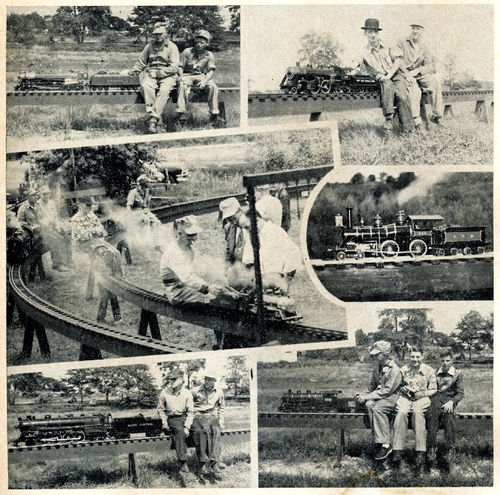
UPSY at BLS Meet
- During the 1952 Brotherhood meeting at Danvers, Mass. "UPSY" made several non stop runs around the big loop which is 1800 feet long and includes a 2.5% grade.
Frank Kaylor's 3-1/2" gauge Pacific running at the 20th annual BLS meet, 1952. Like the other locos of the Southeastern Live Steamers, this job had one of Otha Hege's turbo-generators.
GGLS Redwood Canyon Meet
A BLS meet was also held at the Golden Gate Live Steamers Redwood Canyon Park track.
